
Sinharaja Rainforest National Park all day.
/This was billed as our endemic extravaganza day – nearly all of Sri Lanka’s endemic bird species can be found in and around the park, we needed 6 more to complete the list:
-
Serendib Scops Owl
-
Green-billed Coucal
-
Red-faced Malkoha
-
Sri Lankan Thrush
-
Ashy-headed Laughingthrush
-
Sri Lankan Spurfowl
After an 8 hour sleep in what can best be described as ‘basic’ accommodation and worse described as a dump! Martin's Lodge is ageing and in desperate need of renovation. We shared our bathroom with 2 million ants and several other creepy crawlies, it is safe to say that I will not be using this place for my tours. The people there are very friendly and the food is good but the accommodation sucks.

Sri Lankan Pit Viper
We got up at 5:30am, so did the ants, in preparation for daylight at 6am and breakfast at 6:30am. We had hoped for more sightings of Sri Lankan Blue Magpie which materialised around 7am. Three of these beautiful birds came very close to the veranda just before we left. We also had good views of Asian Brown Flycatcher, Small Minivet, White-bellied Drongo and several other species.

This Kangeroo Lizard has the ability to run or skip across water.
We set off for the park and we hadn’t walked 100 meters when we got a trip tick in form of a Black-throated Munia, several of them showed well and completed the ‘Munia set’. Once inside the park we search for our most wanted species, the Serendib Scops Owl, this bird had been seen at a regular roost site just inside the park, but unfortunately for us it had’t been seen there for about 6 days!

The Tree Nymph Butterfly is very common in the forest
Undeterred we ventured further into the forest, it was a typical rainforest walk, nothing was seen for 20 minutes then a flurry of activity had us searching the canopy for a mixed feeding flock. We found Black-naped Monarch, Asian Paradise Flycatcher, we had brief inconclusive views of Red-faced Malkoha but great views of another trip tick, the Dark-fronted Babbler.
A local volunteer warden was with us and his local knowledge was invaluable, he put us straight on to a pair of Sri Lankan Frogmouths.

can you make out two Frogmouths here?
A little further along the track we added Yellow-browed Bulbul to the list, this species is a fairly common species which had eluded us up until now. Another flurry of activity produced superb views of Ashy-headed Laughingthrush, there were at least 4 of them in a flock (they are essentially a babbler not a thrush) whilst watching them we found our second only Malabar Trogon.

a species of unidentified moth
Then after a two mile walk we found ourselves near a small research centre where a couple of streams flowed down through the forest. Looking high up in the tree canopy Jith located a small party of Red-faced Malkohas, we had great in-the-scope views, a fantastic looking bird and considering its size, ver hard to find.
We sat for a rest outside the reseaech centre, this area is where we planned to look for the endemic Sri Lankan Thrush, this very shy and elusive bird can be along the side of the streams on the forest floor.
The girls gave this walk a miss as we were going to go off-track to look for the bird, I didn’t blame them, it was very hot and humid. We followed our guides through thickets and mud and water, hot and sweaty, lovely. We spent almost an hour chasing shadows and listening for little calls, eventually we got very brief, flight-sightings before we gave up.

birding in the forest this morning
After an hour's rest we resumed our search, we promised the girls that this would be a shorter search. Indeed it was because after 20 minutes we had fantastic views of the bird for at least 5 minutes, wow that was worth the effort.
Back with our wives we saw another Sri Lankan Blue Magpie, several lovely butterflies, a snake and a lovely Orchid. We then walked back to the lodge for lunch and a most welcomed break. We had seen three of our wanted endemics but the owl was still a priority so John and I joined Jith, Thilina and a park ranger to look again for it. Just before we left a Besra flew in front of the veranda, another trip-tick.

Orchid species
Our third excursion was centred around areas outside the park, we concentrated on places where the owl had been seen in the past. Our guides worked hard but came up with nothing, never mind, there is always tomorrow.
Three endemic species remain to be found, watch this space…………….
